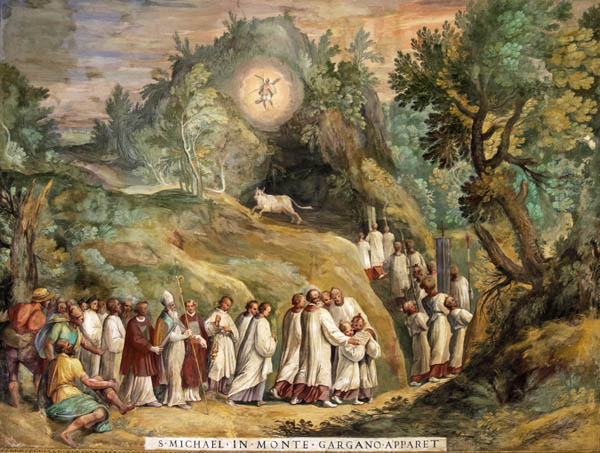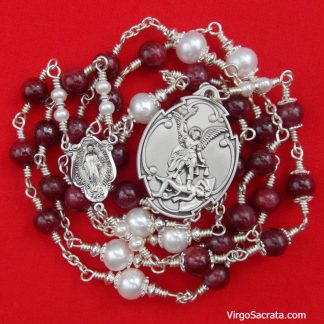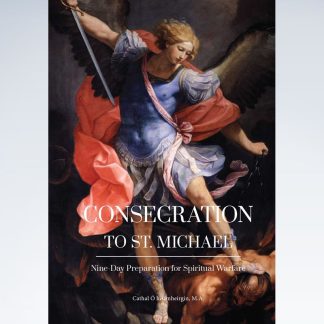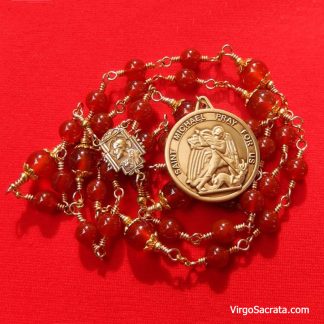

Today’s feast commemorates an apparition of St. Michael the Archangel on Monte Gargano in southern Italy in the year 492. Traditionally in the Liturgy of the Church there are two feasts of St. Michael in the Universal Calendar: May 8 and September 29. According to the Roman Breviary, the feast was instituted to thank God for a military victory achieved at Monte Gargano, Italy, on May 8 , 663, through the intercession of St. Michael.
First Apparition
The first apparition, known as the bull episode, is dated 490; it is the most astonishing and tells the story of a rich lord who went in search of a bull of his herds, lost in the Gargano area; at last he found it on the top of the mountain kneeling down at the opening of a cave. Filled with anger, he shot an arrow against the rebellious animal, but instead of hitting the bull the arrow unaccountably wounded the foot of the wealthy man.
Upset by the event, he went to see the Bishop who, after listening to the account of the extraordinary adventure, ordered three days of prayers and penance. As the third day ended, the Archangel Michael appeared to the Bishop and spoke to him:
“I am the Archangel Michael and I am always in the presence of God. The cavern is sacred to me, I have chosen it; I myself am its watchful custodian… There where the rock opens wide the sins of men can be forgiven… What is asked here in prayer will be granted. Therefore, go to the mountain and dedicate the grotto to the Christian religion”.
Second Apparition
The second apparition, known as the victory episode, is linked to a memorable victory of the town of Siponto against the enemy troops; the complete victory, foretold by the Archangel during His apparition to the holy Bishop Lawrence Maiorano, took place on May 8th and the Longobards attributed it to the intercession and help of the Archangel.
Third Apparition
The third apparition, also called the Dedication episode, is linked to the beginning of the cult on the Gargano when all the Apulian bishops went in procession to the holy grotto and they found that a primitive altar had already been erected, as announced by the Archangel to Lawrence Maiorano; moreover, according to the legend, they found St. Michael’s footprint in the rock.
Gargano is one of the most advanced eastward land of Italy and so, thanks to its geographical position and the fame acquired for these apparitions, the Byzantines held it under their dominion together with some other regions of the Adriatic coast.
During this period the Sanctuary structure was very different from the current one. Pilgrims arrived at the shrine from the Carbonara valley through a portico and a gallery that gave on to the irregular and deep cavern.
Then, in this period, according to the oriental liturgy, St. Michael was venerated as the one who presents the souls of dead to the divine throne and as a healer of illnesses rather than as a great warrior. It was very famous the so-called “drop”: a miraculous water that dripped from the rock of the cavern and, according to the tales, healed every kind of diseases.
Source: Sanctuary of San Michele Arcangelo.
“Before you go to me here … go to Monte Sant’Angelo and call for the help and protection of St. Michael Archangel” Cit. Padre Pio.
St. Michael is invoked several times at Low Mass in Confiteors and in the Leonine Prayers after Mass. During the blessing of incense at the Offertory where the priest prays that “through the intercession of Blessed Michael the Archangel, standing at the right of the altar of incense, the Lord may deign to bless this incense, and receive it in an odour of sweetness.”

-
St Michael the Archangel Chaplet in Sterling Silver with Ruby GemstonesUS$ 465.00
-
Consecration to St Michael – Nine Day Preparation for Spiritual WarfareUS$ 18.00
-
Saint Michael the Archangel 100% Pure Beeswax Votive CandlesUS$ 33.00 – US$ 59.00
-
Pope Leo XIII and the Prayer to Saint MichaelUS$ 22.00
-
Chaplet of St. Michael the ArchangelUS$ 139.00
-
St. Michael the Archangel Medal Pendant 1″US$ 70.00 – US$ 1,847.00
VIRGÓ SACRÁTA is a Christian mission-driven online resource and shop inspired from the beauty of Catholic faith, tradition, and arts. Our mission is to “Restore All Things to Christ!”, in continuing the legacy of Pope St. Pius X under the patronage of the Blessed Virgin Mary. “Who is she that cometh forth as the morning rising, fair as the moon, bright as the sun, terrible as an army set in battle array?” O Mary, conceived without sin, pray for us who have recourse to Thee.








